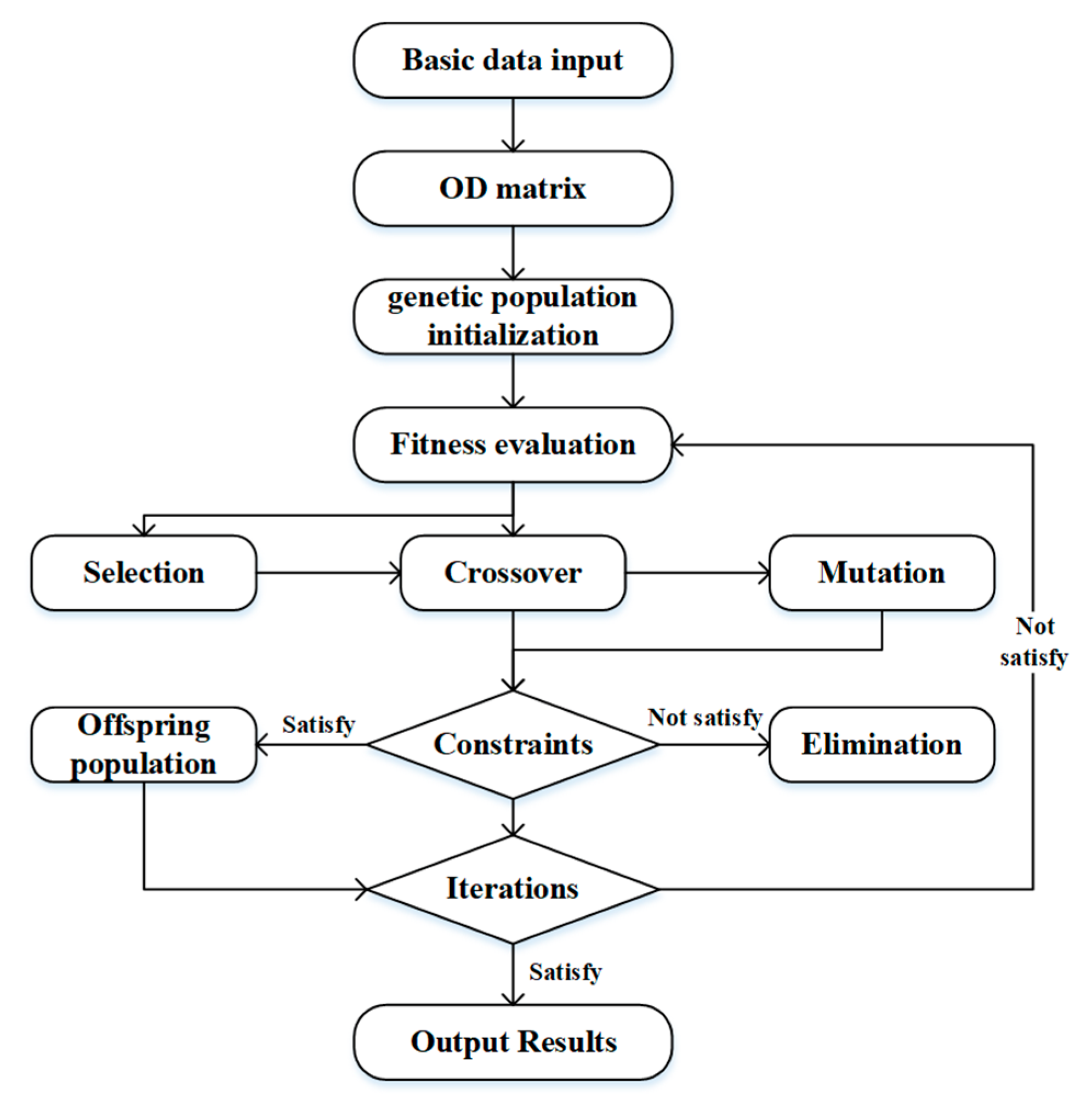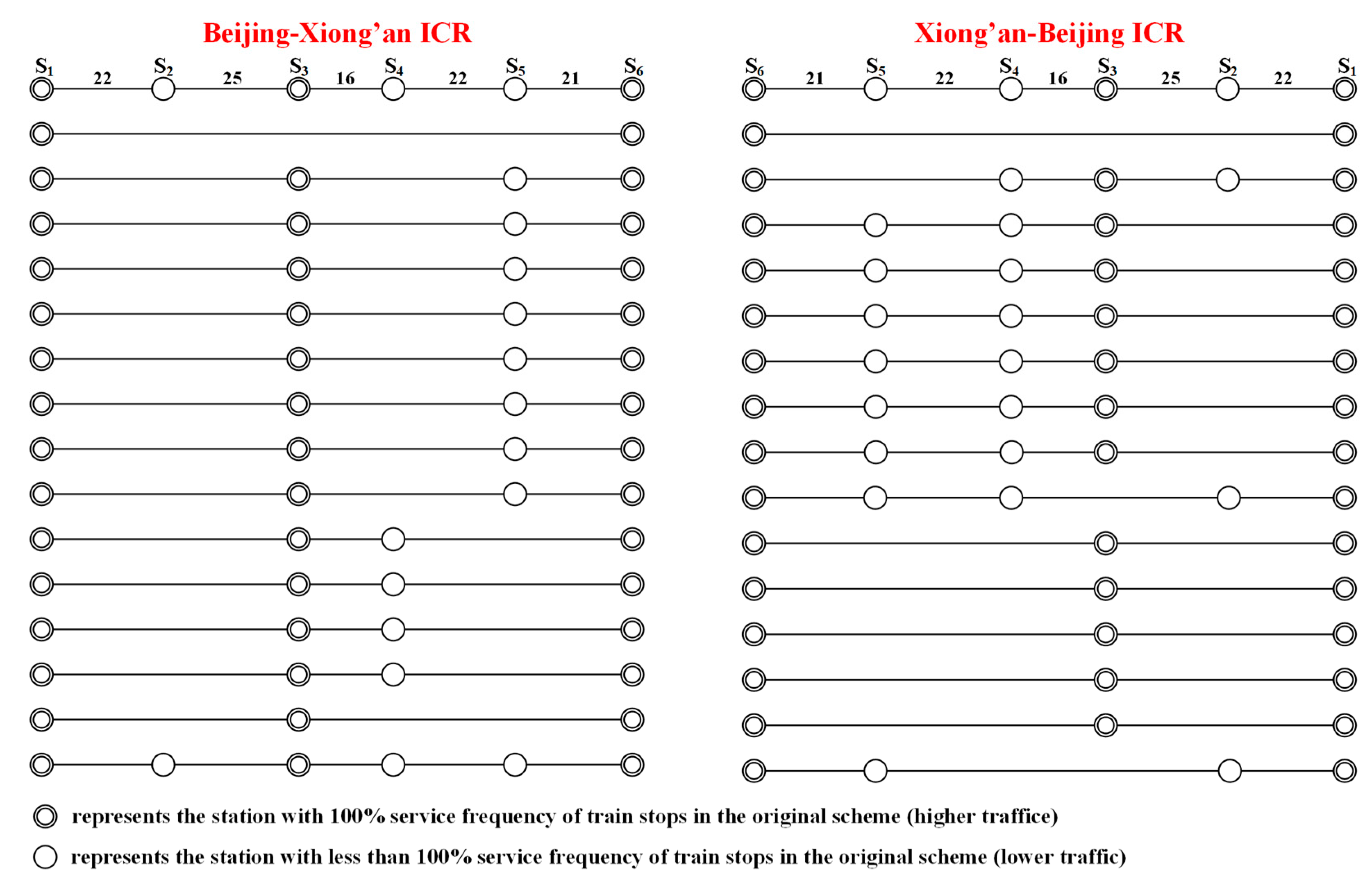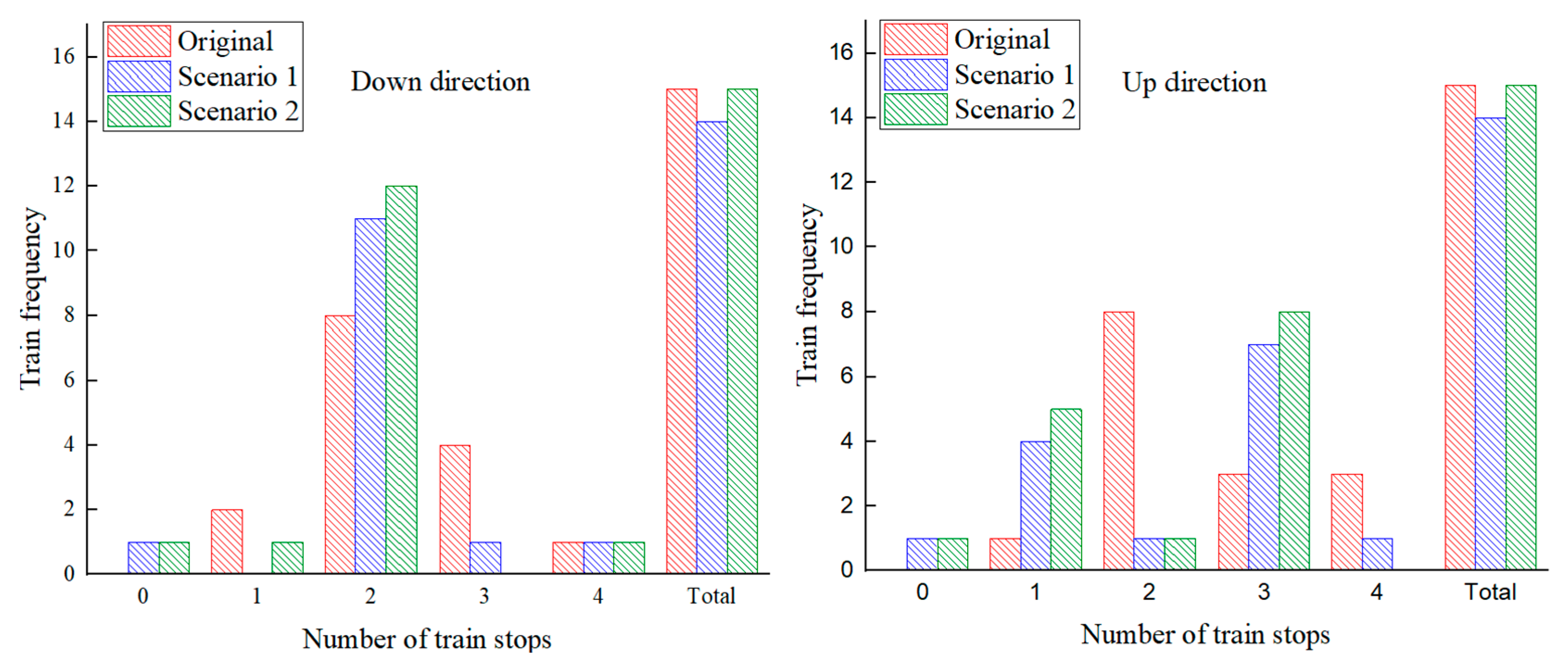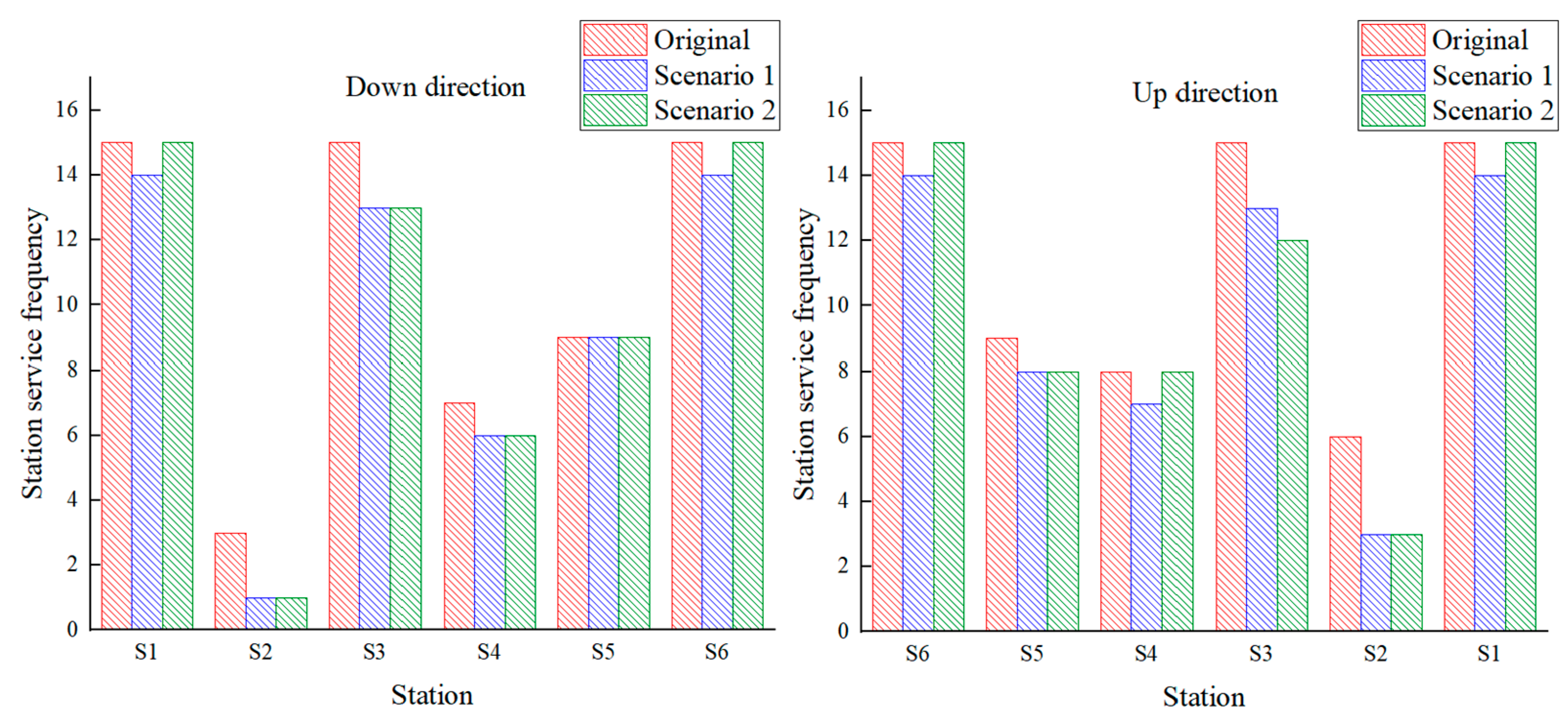A Multi-Objective Optimization Model for the Intercity Railway Train Operation Plan: The Case of Beijing-Xiong’an ICR
Abstract
:1. Introduction
2. Literature Review
2.1. Railway Train Operation Plan
2.2. Research Ideas
3. Mathematical Model
3.1. Problem Description
3.2. Model Assumptions
- (1)
- Closed assumption
- (2)
- Deterministic assumption
- (3)
- No transfer assumption
- (4)
- Capability assumption
- (5)
- Passenger time value assumption
3.3. Model Notations
3.4. Mathematical Model
3.4.1. Objective Functions
- (1)
- Minimize the operating cost of intercity railway enterprises
- (2)
- Minimize the travel time of passengers
3.4.2. Constraint Conditions
3.5. Processing of Multi-Objective
4. Methods
4.1. Genetic Algorithm Design
- (1)
- Chromosome Coding
- (2)
- Fitness Evaluation
- (3)
- Crossover and Mutation Operation
4.2. Computing Procedure
5. Case Study
5.1. Data
5.2. Results
- (1)
- Scenario 1 optimization plan
- (2)
- Scenario 2 optimization plan
5.3. Discussion
5.3.1. Number of Train Stops
5.3.2. Station Service Frequency
5.3.3. Comparison of Important Indicators
- (1)
- Down direction
- (2)
- Up direction
6. Conclusions
- The influence of the change in passenger travel time value on the train operation plan is considered. A multi-objective optimization model aiming at the minimum operating cost of the enterprise and the minimum consumption time of passengers is constructed.
- According to the characteristics of the model, a genetic algorithm is designed to solve the model. The algorithm is calculated on the MATLAB platform, and the optimal solution can be obtained quickly.
- Taking BXICR as a research case, two types of intercity railway train operation plan under different travel time values of passengers are obtained. Scenario 1 runs 14 pairs of trains, which saves a lot of operating costs for the company; Scenario 2 runs 15 pairs of trains, which saves a lot of travel time for passengers.
- Comparing and analyzing different train operation plans, the results show that both optimization plans are better than the original plan. In the down direction, operating costs in Scenario 1 and Scenario 2 decreased by 7.3% and 1.1%, total time consumption decreased by 1.1% and 1.7%, and the number of stops per train for two scenarios decreased by 8.8% and 14.9%, respectively. In the up direction, operating costs in Scenario 1 and Scenario 2 decreased by 7.7% and 1.6%, total time consumption decreased by 0.7% and 1.5%, and the number of stops per train for two scenarios decreased by 12.6% and 18.2%, respectively. The optimized plan reduces the operating cost of the enterprise, attracts more passenger flow, and realizes the sustainable development of the intercity railway enterprise.
- The model established in this paper is a general model suitable for the optimization of the train operation plan of the ICR, taking the Beijing-Xiong‘an Intercity Railway as a case study. ICRs similar to BXICR include Beijing-Tianjin ICR, Nanchang-Jiujiang ICR, Guangzhou-Zhuhai ICR and Wuhan-Huangshi ICR, etc. After investigation, the length and average daily passenger flow of these lines are at the same level as the BXICR. The optimization model established in this paper can be applied to the above-mentioned similar lines, and similar conclusions can be obtained, including the reduction in the total operating costs, the reduction in the number of stops per train, and the reduction in the total time consumption.
- Due to the limited data collection capacity, this paper studies the ICR passenger flow under the condition of fixed demand. In the actual operation process, the passenger flow has strong uncertainty, and the change in the passenger flow law in different periods will also affect the preparation of the train operation plan. In future research, it is necessary to combine passenger flow forecasting and other information, and consider factors other than the train operation plan as comprehensively as possible, so as to strengthen the applicability of the model.
Author Contributions
Funding
Institutional Review Board Statement
Informed Consent Statement
Data Availability Statement
Conflicts of Interest
References
- Philine, G.; Jonas, H.; Anita, S. Line pool generation. Public Transp. 2017, 9, 7–32. [Google Scholar]
- Jin, G.; He, S.; Li, J.; Li, Y.; Guo, X.; Xu, H. An Integrated Model for Demand Forecasting and Train Stop Planning for High-Speed Rail. Symmetry 2019, 11, 720. [Google Scholar] [CrossRef] [Green Version]
- Chang, Y.; Yeh, C.; Shen, C. A multiobjective model for passenger train services planning: Application to Taiwan’s high-speed rail line. Transp. Res. Part B Methodol. 2000, 34, 91–106. [Google Scholar] [CrossRef]
- Fu, H.; Nie, L.; Sperry, B.R.; He, Z. Train Stop Scheduling in a High-Speed Rail Network by Utilizing a Two-Stage Approach. Math. Probl. Eng. 2012, 2012, 579130. [Google Scholar] [CrossRef]
- Han, P.; Nie, L.; Fu, H.; Gong, Y.; Wang, G. A Multiobjective Integer Linear Programming Model for the Cross-Track Line Planning Problem in the Chinese High-Speed Railway Network. Symmetry 2019, 11, 670. [Google Scholar] [CrossRef] [Green Version]
- Wang, L.; Jia, L.-M.; Qin, Y.; Xu, J.; Mo, W.-T. A two-layer optimization model for high-speed railway line planning. J. Zhejiang Univ. Sci. A 2011, 12, 11. [Google Scholar] [CrossRef]
- Xin, Z.; Huiling, F.; Lu, T. Optimizing the High Speed Train Stop Schedule Using Flexible Stopping Patterns Combination. In Proceedings of the 17th International IEEE Conference on Intelligent Transportation Systems II, Qingdao, China, 8–11 October 2014; p. 6. [Google Scholar]
- Zhang, X.; Nie, L.; Wu, X.; Ke, Y. How to Optimize Train Stops under Diverse Passenger Demand: A New Line Planning Method for Large Scale High-Speed Rail Networks. Netw. Spat. Econ. 2020, 20, 963–988. [Google Scholar] [CrossRef]
- Lin, D.; Ku, Y. An implicit enumeration algorithm for the passenger service planning problem: Application to the Taiwan Railways Administration line. Eur. J. Oper. Res. 2014, 238, 863–875. [Google Scholar] [CrossRef]
- Yang, L.; Qi, J.; Li, S.; Gao, Y. Collaborative optimization for train scheduling and train stop planning on high-speed railways. Omega 2016, 64, 57–76. [Google Scholar] [CrossRef]
- Lai, Y.C.; Shih, M.C.; Chen, G.H. Development of efficient stop planning optimization process for high-speed rail systems. J. Adv. Transp. 2016, 50, 1802–1819. [Google Scholar] [CrossRef]
- Yamauchi, T.; Takamatsu, M.; Imahori, S. Optimizing train stopping patterns for congestion management. In Proceedings of the 17th Workshop on Algorithmic Approaches for Transportation Modelling, Optimization, and Systems (ATMOS 2017), Vienna, Austria, 7–8 September 2017. [Google Scholar] [CrossRef]
- Huang, W.; Shuai, B. Approach and application on high-speed train stop plan for better passenger transfer efficiency: The China case. Int. J. Rail Transp. 2018, 7, 55–78. [Google Scholar] [CrossRef]
- Ehab, A.A.; Mohamed, R.S.; Mohamed, A.S. Minimizing passenger travel time in URT system adopting skip-stop strategy. J. Rail Transp. Plan. Manag. 2017, 7, 277–290. [Google Scholar]
- Jong, J.; Suen, C.J.; Chang, S.K.J. Decision Support System to Optimize Railway Stopping Patterns: Application to Taiwan High-Speed Rail. Transp. Res. Record 2012, 2289, 24–33. [Google Scholar] [CrossRef]
- Chen, D.; Ni, S.; Xu, C.; Lv, H.; Wang, S. High-Speed Train Stop-Schedule Optimization Based on Passenger Travel Convenience. Math. Probl. Eng. 2016, 2016, 8763589. [Google Scholar] [CrossRef] [Green Version]
- Qi, J.; Yang, L.; Di, Z.; Li, S.; Yang, K.; Gao, Y. Integrated optimization for train operation zone and stop plan with passenger distributions. Transp. Res. Part E Logist. Transp. Rev. 2018, 109, 151–173. [Google Scholar] [CrossRef]
- Yue, Y.; Wang, S.; Zhou, L.; Tong, L.; Saat, M.R. Optimizing train stopping patterns and schedules for high-speed passenger rail corridors. Transp. Res. Part C Emerg. Technol. 2016, 63, 126–146. [Google Scholar] [CrossRef]
- Qi, J.; Cacchiani, V.; Yang, L.; Zhang, C.; Di, Z. An Integer Linear Programming model for integrated train stop planning and timetabling with time dependent passenger demand. Comput. Oper. Res. 2021, 136, 105484. [Google Scholar] [CrossRef]
- Qi, J.; Li, S.; Yang, K.; Liu, P.; Gao, Y. Joint optimization model for train scheduling and train stop planning with passengers distribution on railway corridors. J. Oper. Res. Soc. 2018, 69, 556–570. [Google Scholar] [CrossRef]
- Dong, X.; Li, D.; Yin, Y.; Ding, S.; Cao, Z. Integrated optimization of train stop planning and timetabling for commuter railways with an extended adaptive large neighborhood search metaheuristic approach. Transp. Res. Part C Emerg. Technol. 2020, 117, 102681. [Google Scholar] [CrossRef]
- Roberto, C.; Francesco, R. Optimizing the demand captured by a railway system with a regular timetable. Transp. Res. Part B Methodol. 2011, 45, 430–446. [Google Scholar]
- Tomáš, R.; Azadeh, S.S.; Maknoon, Y.; de Lapparent, M.; Bierlaire, M. Train timetable design under elastic passenger demand. Transp. Res. Part B 2018, 111, 19–38. [Google Scholar]
- Dedík, M.; Zitrický, V.; Valla, M.; Gašparík, J.; Figlus, T. Optimization of Timetables on the Bratislava–ilina–Koice Route in the Period after the End of the COVID-19 Pandemic. Sustainability 2022, 14, 5031. [Google Scholar] [CrossRef]
- Daly, A.; Hess, S. VTT or VTTS: A note on terminology for value of travel time work. Transportation 2019, 47, 1359–1364. [Google Scholar] [CrossRef] [Green Version]
- Hensher, D.A. Towards a practical method to establish comparable values of travel time savings from stated choice experiments with differing design dimensions. Transp. Res. Part A Policy Pract. 2006, 40, 829–840. [Google Scholar] [CrossRef]
- Tseng, Y.; Verhoef, E.T. Value of time by time of day: A stated-preference study. Transp. Res. Part B Methodol. 2008, 42, 607–618. [Google Scholar] [CrossRef] [Green Version]
- Fezzi, C.; Bateman, I.J.; Ferrini, S. Using revealed preferences to estimate the Value of Travel Time to recreation sites. J. Environ. Econ. Manag. 2014, 67, 58–70. [Google Scholar] [CrossRef]
- Athira, I.; Muneera, C.; Krishnamurthy, K.; Anjaneyulu, M. Estimation of Value of Travel Time for Work Trips. Transp. Res. Procedia 2016, 17, 116–123. [Google Scholar] [CrossRef]
- Gautam, A. Estimation of Value of Travel Time Saving for Commuter Trips A Case Study of Kathmandu. In Proceedings of the 8th IoE Graduate Conference, Kathmandu, Nepal, 1 August 2021. [Google Scholar]










| Notations | Definition |
|---|---|
| Intercity railway line, G = (S, E) | |
| Intercity railway station, s, i, j ∈ S | |
| Train running sections | |
| Line length | |
| Distances between i and j | |
| m | Train stop mode, m ∈ M = {m0, m1, m2, m3} |
| Stop plan for m stop mode, km ∈ Km | |
| The fixed cost of all trains | |
| The stop cost of all trains | |
| The running cost of all trains | |
| The time consumption with train stops | |
| The time consumption with train running | |
| Train capacity | |
| The stop time of station s, s ∈ S | |
| The stop cost of station s, s ∈ S | |
| Running cost, CNY per train per kilometer | |
| Fixed cost of an intercity train | |
| Average running speed between i and j by train with the stop plan km | |
| The passenger flow transported by train with the stop plan km | |
| The total passenger flow that needs to be transported between i and j | |
| Average passenger time value | |
| Maximum occupancy rate | |
| Minimum occupancy rate | |
| Maximum number of trains of m stop mode | |
| Minimum number of trains of m stop mode | |
| Maximum number of trains stops of m stop mode | |
| Minimum number of trains stops of m stop mode | |
| Maximum starting capacity |
| Decision Variables | Definition |
|---|---|
| 0–1 variable; 1 means train running with stop plan km stops at station s; 0 means otherwise | |
| The frequency of train running with stop plan km |
| Parameter | Value |
|---|---|
| Train type | CR400AF EMU |
| Starting/terminal station | Beijingxi/Xiong’an |
| Running speed | 250~350 km/h |
| Stop time | 3 min (Including start and stop additional time) |
| Train formation | 8 carriages |
| Seating capacity | 576 seats |
| ) | 0.5/0.75 ¥/min |
| Fixed cost | 8000 ¥ |
| Stop cost | 500 ¥ |
| Running cost | 60 ¥/km |
| Departure capacity | 100 trans/day |
| Stations | S1 | S2 | S3 | S4 | S5 | S6 |
|---|---|---|---|---|---|---|
| S1 | — | 15 | 1696 | 430 | 1404 | 3351 |
| S2 | 50 | — | 12 | 8 | 24 | 29 |
| S3 | 1411 | 31 | — | 77 | 216 | 767 |
| S4 | 573 | 16 | 124 | — | 7 | 28 |
| S5 | 1302 | 16 | 266 | 11 | — | 40 |
| S6 | 3178 | 77 | 833 | 41 | 38 | — |
| Direction | Scenarios | Number of Train Stops | Total Frequency | Average Stop Times (per Train) | ||||
|---|---|---|---|---|---|---|---|---|
| 0 | 1 | 2 | 3 | 4 | ||||
| Up direction | Original/freq | 0 | 2 | 8 | 4 | 1 | 15 | 2.27 |
| Scenario 1/freq | 1 | 0 | 11 | 1 | 1 | 14 | 2.07 | |
| Scenario 2/freq | 1 | 1 | 12 | 0 | 1 | 15 | 1.93 | |
| Down direction | Original/freq | 0 | 1 | 1 | 8 | 3 | 15 | 2.53 |
| Scenario 1/freq | 1 | 4 | 1 | 7 | 1 | 14 | 2.21 | |
| Scenario 2/freq | 1 | 5 | 1 | 8 | 0 | 15 | 2.07 | |
| Direction | Scenarios | Stations | Total | |||||
|---|---|---|---|---|---|---|---|---|
| Beijingxi | Beijing Daxing | Daxing Airport | Gu’an dong | Bazhou bei | Xiong’an | |||
| Up direction | Original | 15 | 3 | 15 | 7 | 9 | 15 | 64 |
| Scenario 1 | 14 | 1 | 13 | 6 | 9 | 14 | 57 | |
| Scenario 2 | 15 | 1 | 13 | 6 | 9 | 15 | 59 | |
| Down direction | Original | 15 | 6 | 15 | 8 | 9 | 15 | 68 |
| Scenario 1 | 14 | 3 | 13 | 7 | 8 | 14 | 59 | |
| Scenario 2 | 15 | 3 | 12 | 8 | 8 | 15 | 61 | |
| Indicators | Original | Scenario 1 | Scenario 2 |
|---|---|---|---|
| Fixed cost/¥ | 120,000 | 112,000 | 120,000 |
| Running cost/¥ | 81,900 | 76,440 | 81,900 |
| Stop cost/¥ | 17,000 | 14,500 | 14,500 |
| Total cost/¥ | 218,900 | 202,940 | 216,400 |
| Stop time/min | 37,421 | 32,612 | 30,224 |
| Running time/min | 393,477 | 393,477 | 393,477 |
| Total time/min | 430,898 | 426,089 | 423,701 |
| Number of stops at intermediate stations | 34 | 29 | 29 |
| Station service frequency | 64 | 57 | 59 |
| OD service frequency | 106 | 92 | 91 |
| Indicators | Original | Scenario 1 | Scenario 2 |
|---|---|---|---|
| Fixed cost/¥ | 120,000 | 112,000 | 120,000 |
| Running cost/¥ | 81,900 | 76,440 | 81,900 |
| Stop cost/¥ | 19,000 | 15,500 | 15,500 |
| Total cost/¥ | 220,900 | 203,940 | 217,400 |
| Stop time/min | 39,512 | 36,637 | 33,389 |
| Running time/min | 370,199 | 370,199 | 370,199 |
| Total time/min | 409,711 | 406,836 | 403,588 |
| Number of stops at intermediate stations | 38 | 31 | 31 |
| Station service frequency | 68 | 59 | 61 |
| OD service frequency | 132 | 104 | 102 |
Publisher’s Note: MDPI stays neutral with regard to jurisdictional claims in published maps and institutional affiliations. |
© 2022 by the authors. Licensee MDPI, Basel, Switzerland. This article is an open access article distributed under the terms and conditions of the Creative Commons Attribution (CC BY) license (https://creativecommons.org/licenses/by/4.0/).
Share and Cite
Fan, Z.; Liu, D.; Rong, W.; Li, C. A Multi-Objective Optimization Model for the Intercity Railway Train Operation Plan: The Case of Beijing-Xiong’an ICR. Sustainability 2022, 14, 8557. https://doi.org/10.3390/su14148557
Fan Z, Liu D, Rong W, Li C. A Multi-Objective Optimization Model for the Intercity Railway Train Operation Plan: The Case of Beijing-Xiong’an ICR. Sustainability. 2022; 14(14):8557. https://doi.org/10.3390/su14148557
Chicago/Turabian StyleFan, Zilong, Di Liu, Wenyu Rong, and Chengrui Li. 2022. "A Multi-Objective Optimization Model for the Intercity Railway Train Operation Plan: The Case of Beijing-Xiong’an ICR" Sustainability 14, no. 14: 8557. https://doi.org/10.3390/su14148557
APA StyleFan, Z., Liu, D., Rong, W., & Li, C. (2022). A Multi-Objective Optimization Model for the Intercity Railway Train Operation Plan: The Case of Beijing-Xiong’an ICR. Sustainability, 14(14), 8557. https://doi.org/10.3390/su14148557






